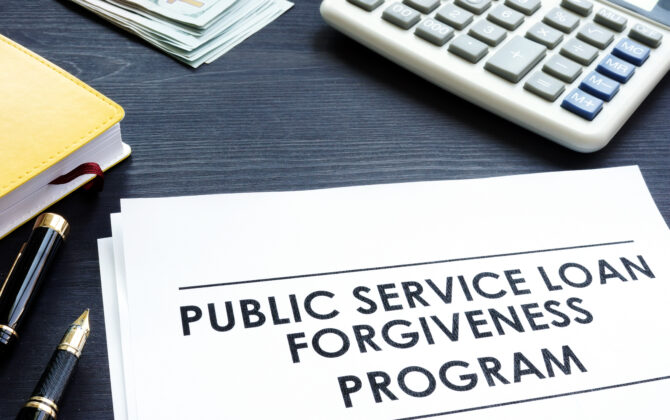The Public Service Loan Forgiveness (PSLF) program1 was created by the US government as part of the College Cost Reduction and Access Act of 2007 and offers a path to forgiveness for federal student loan borrowers working full-time for the government or a qualifying nonprofit organization.
This program is only available to federal student loan borrowers (it’s important to note that the PSLF program is not available for private student loans). Federal Student Aid began accepting and reviewing applications to the program in 2017. Since then, $69.2 billion of student loan debt has been discharged through the program (as of July 2024), according to the Education Department (ED).
Additionally, the rules and requirements for PSLF have changed multiple times since the program’s inception. Read on for a deeper understanding of how the PSLF program works and what types of public sector jobs could qualify. You can also learn more at laurelroad.com/student-loan-forgiveness/.
What is PSLF?
The 10-year PSLF program allows borrowers employed at government organizations and qualifying nonprofit organizations to have their federal Direct Loans forgiven after ten years of repayment (or 120 qualifying payments). Here’s how it works.
How does PSLF work?
To pursue and qualify for PSLF, 120 qualifying monthly payments must be made under a qualifying repayment plan — typically, an Income-Driven Repayment (IDR) plan — paid on-time (within 15 days of due date) and in the full due amount. The different types of IDR plans that qualify include:
IDR Comparison Chart
|
Applications for IDR plans and loan consolidation are available on http://studentaid.gov. You can also submit a PDF application to your loan servicer by uploading it to your servicer’s website or mailing it to them. Expect a delay in processing times. |
|
Plan |
Monthly Payments |
Repayment Period |
Status |
|
Income-Based Repayment (IBR) |
- 10-15% of your discretionary income (and your spouse’s if filing jointly)
- Never more than federal 10-year Standard Repayment Plan amount
|
20-25 years, depending on when you become a new borrower |
Accepting new enrollments. |
|
Income-Contingent Repayment (ICR) |
The lesser of the following: - 20% of your discretionary income or
- What you would pay on a repayment plan with a fixed payment over the course of 12 years, adjusted according to your income
|
25 years |
Accepting new enrollments. |
|
Pay as You Earn (PAYE) |
- 10% of your discretionary income (and your spouse’s if filing jointly)
- Never more than federal 10-year Standard Repayment Plan amount
|
20 years |
Accepting new enrollments. |
What jobs qualify for PSLF?
As for job types and titles, qualifying employment for the PSLF Program is more about your employer than the job you do. As a full-time government employee (federal, state, local, or tribal), you’re eligible for PSLF. You could even be eligible for PSLF as a government contractor, so long as you’re directly employed by a qualifying employer — such as a nonprofit — that is doing work under a government contract. Just note that as a contractor, you’re generally considered full-time if you work at least 30 hours per week or if you meet your employer’s definition of full-time — whichever is greater.
Qualifying for PSLF as a nonprofit employee
If you’re employed by a nonprofit, the general rule is that it needs to be tax-exempt under Section 501(c)(3) of the Internal Revenue Code. However, there’s a chance you could be eligible for PSLF even if your organization is not a 501(c)(3) nonprofit. According to studentaid.gov, a nonprofit that is not tax-exempt under section 501(c)(3) could be considered a qualifying employer if it provides certain types of qualifying public services. For example, eligible not-for-profit organizations include most private elementary and secondary schools, private colleges and universities, and many other organizations.
A not-for-profit organization that is not exempt under section 501(c)(3) of the Internal Revenue Code is considered a qualifying employer if it provides at least one of the following public services:
- Emergency management
- Military service (on behalf of the US armed forces or the National Guard) or civilian service to the military
- Public safety
- Law enforcement: crime prevention, control or reduction of crime, or the enforcement of criminal law
- Public interest law services
- Early childhood education
- Public service for individuals with disabilities or older adults
- Public health
- Public safety
- Public education
- Public library services
- School library or other school-based services
Learn more here.
Common job types that qualify for PSLF
Common jobs that could qualify for PSLF include:
- Healthcare workers such as:
- Doctors
- Physician Assistants
- Nurses
- EMTs
- Hospital support personnel
- Therapists
- Mental Health Counselors
- Other HCPs
- Educators such as:
- K-12 teachers
- Special education teachers
- Student aides
- Professors
- School administrators
- Librarians
- School support personnel
- First responders employed by federal, state, local or tribal governments, such as:
- Law enforcement professionals
- Firefighters
- EMTs
- Active-duty military personnel
- Government personnel employed by federal, state, local or tribal governments, such as:
- Officials
- Aides and support personnel
- Social workers
- Researchers
- Contract workers
- Compensated volunteer and non-profit work such as:
To better understand your PSLF eligibility, take our quiz below. You can also use the employer search tool on studentaid.gov to see if your current and past employers are on the eligible list.
Jobs that don’t qualify for PSLF
To further understand what types of jobs and employers typically do qualify for PSLF, it can be helpful to understand the ones that do not. Here’s a short list:
- For-profit organizations, including for-profit government contractors
- Labor unions
- Partisan political organizations
Learn more about job types, employers, and employment circumstances that do not qualify for PSLF.
How to apply for PSLF
Getting in and staying in the PSLF program is a notoriously challenging process with a high rejection rate. According to June 2023 data from studentaid.gov, only 3.3% of all processed PSLF applications have been approved, (121,221 approved for discharge among 3,728,674 total applications). To pursue and qualify for PSLF, you will need to follow these general steps:
Learn more about applying for PSLF at studentaid.gov/pslf/. For expert guidance on the PSLF application process, schedule a free consultation with one of our student loan specialists.
Alternatives if your job doesn’t qualify for PSLF
If you don’t qualify for PSLF, you still have other options for federal student loan forgiveness through IDR programs. Learn more about forgiveness through IDR programs at laurelroad.com/income-driven-repayment/ and contact us for a free 30-minute student loan forgiveness consultation. Our student loan specialists can help you compare IDR options and determine which program is best for you.
Final words: PSLF qualifying jobs
For many working Americans, PSLF is a financial lifeline that significantly eases the burden of student loan debt, making it possible to actualize a successful career in public service. While expanded eligibility criteria and waivers have helped make PSLF available to more federal student loan borrowers, many public sector professionals still find the constantly changing legislative landscape as well as the paperwork required for the program to be daunting and time-consuming.
If you’re starting the PSLF application process or are unsure about whether your current or past employment qualifies for PSLF, schedule a free consultation with our student loan specialists to have your questions answered and learn more about all the forgiveness options available to you.




